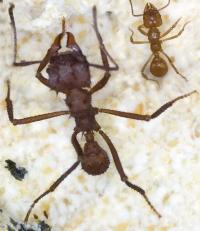
Acromyrmex leaf-cutting ants -- large and small workers. The discovery of a flexible genetic coding in leaf-cutting ants sheds new light on how one of nature's ultimate self-organising species breeds optimum numbers of each worker type to ensure the smooth running of the colony.
Research at the University of Leeds shows that despite an inherited genetic pre-disposition to grow into a particular worker caste, ant larvae can be triggered by environmental stimuli to switch development depending on colony's workforce needs.
"Our previous research suggested that genetics did indeed play a part in caste determination - but not how much of a part," says evolutionary biologist Dr William Hughes of the Faculty of Biological Sciences. "This left us with a conundrum: ant colonies are a model of social efficiency, yet if genetics ruled caste development, then this would be a very rigid - and therefore very inefficient - method of ensuring an optimum workforce balance."
"It seems that ants have evolved their own solution to this problem. Given that it takes an ant eight weeks to develop from an egg into an adult, ant colonies have to predict the need for different types of worker well in advance, and a flexible combination of nature and nurture will help them do this."
Dr Hughes' research used colonies of Acromyrmex leaf-cutting ants, which have two distinct worker castes: large workers, which forage and build the nest and small workers, which care for the ant larvae and the fungus they eat. Worker ants are always female and the large workers are up to three times the size of the smaller ones. "Males don't do much other than eat, fly off, mate and die," says Dr Hughes.
As leaf-cutting queens mate with multiple males, they make good candidates for examining role of genetics in caste determination. With the same mother and rearing conditions, the only differences between workers within a colony will be the genes inherited from their different fathers.
To see if genetic pre-disposition was fixed, all the large workers were removed from a colony to stimulate the need for more larvae to develop into this caste. The results showed that genetic types that didn't normally develop into large workers did so when the need for this caste was increased, proving that the genetic influence is adaptable.
Leaf-cutting ants have an enormous ecological impact because of the amount of leaves they harvest and are a significant pest for several crops. They particularly like citrus and Eucalyptus trees and a colony of the Atta species can defoliate a tree in a single night. They have been estimated to remove 17 per cent of leaf production in some tropical forests. Understanding how colonies function may well offer new opportunities to control their impact.
"We don't yet know what environmental cues influence the caste destiny of the larvae – it could be the food they're fed, the temperature, or even pheromones," says Dr Hughes.
Dr Hughes' research has been published online in Proceedings of the Royal Society B: Biological Sciences.
Source : University of Leeds
 Print Article
Print Article Mail to a Friend
Mail to a Friend
